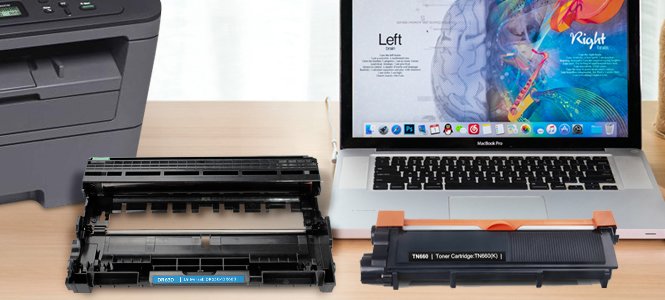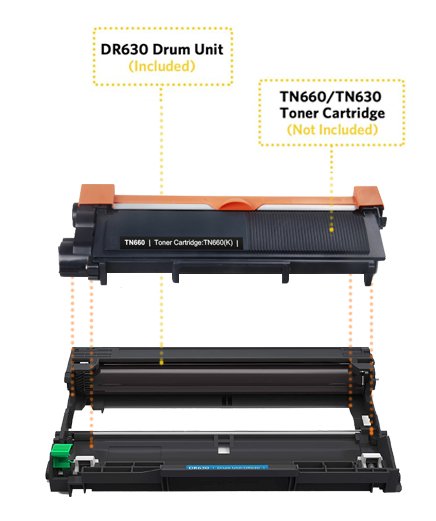Drum and Toner Separation vs Drum and Toner in-one, How should I choose?

Home-use laser printers mainly have two structures, one is drum and toner separation, the other is drum and toner in-one. What is the difference between them? How should we choose from them? Before we buy a laser printer, we can start with the printer cartridge to better understand what kind of printer we may need. Let’s jump in!
Drum and Toner in-one structure
The toner cartridge and drum unit in the printer are integrated and cannot be separated. Most of the consumables of Canon, HP and Samsung laser printers adopt the drum and toner in-one structure. Representative models: HP Q2612A and Canon 104, etc. Once the toner cartridge with this structure is exhausted, the whole toner cartridge shall be replaced. In fact, many of these parts still have a relatively long service life. For example, the drum core can generally support 3-5 times, and the charging roller and magnetic roller can support 5-10 times. Therefore, the drum and toner in-one structure is easy to cause waste. In order to save costs, many people refill the toner by themselves after the toner ran out, but toner refilling will have a great impact on the printing effect because of the quality of toner. As a professional toner cartridge sales enterprise, v4ink does not recommend that refilling the toner by yourself to solve the cost problem.
Drum and Toner Separation Structure
Drum and toner separation refers to the product is divided into independent drum unit and toner cartridge. Before installed into the printer, you must need to put the toner cartridge into the drum unit. The representative models are TN660 and DR630, TN760 and DR730.

As we all know, TN660 and DR630 must be used together, as well as TN760 and DR730. If only put the TN660 Toner Cartridge into the printer alone, the printer is not able to operate normally without DR630.
Why does this structure appear?
In fact, drum and toner separation structure is designed for the benefit of users and minimizing the cost of consumables.
Generally, the life of the drum unit is much longer than that of the toner cartridge. For example, the page yield of TN660 is 2600, while that of DR630 is 12000. That is, the average replacement of 4.5 toner cartridges requires a drum unit replacement. Therefore, a drum unit without damage can support multi toner cartridge successively.
The biggest advantage of drum and toner separation is that when the toner cartridge is exhausted, only the toner cartridge needs to be replaced, which makes full use of the service life of the drum unit, greatly reduces the printing cost and protects the environment.
Advantages and disadvantages of drum and toner separation and drum and toner in-one structure:
| Structure | Drum and toner in-one | Drum and toner separation |
| Feature | Photosensitive drum, developing roller and toner box are integrated | The toner cartridge and the drum unit are two independent parts, one is the photosensitive drum, the other is the developing roller and the toner box |
| Advantage | Compact structure and high space utilization | The toner cartridge and drum unit can be replaced separately to save cost |
| Disadvantage | If one of the parts is damaged, the whole toner cartridge needs to be replaced, and the cost is high | The service life of each component are not as good as the drum and toner in-one, and it needs to be replaced in time |
How to select a suitable laser printer
After you have a preliminary understanding of the drum and toner in-one and drum and toner separation structure, you can choose the appropriate printer according to your own needs. At present, there are many kinds of laser printers on the market. The following main points must be understood before selecting a suitable laser printer:
1. When selecting a printer, you should first clarify its purpose
First of all, make it clear whether you use it at home or in the office. Print more files or pictures. Do you want a single printer or a multi-in-one printer that combines printing, copying and fax? The amount of printing used in the home may not be too large, while the amount of printing used in the office is generally very large. Small portable laser printers, such as brother MFC-L2710dw and MFC-L2700dw, can be considered for use in homes or small offices.
2. Focus on basic functions such as service cycle and printing speed
Printing speed, also known as PPM or pages per minute, may vary greatly between different laser printer models. Most budget friendly models will print at 25 to 50 pages per minute. Brother hl-l2300d is a monochrome laser printer that prints 27 pages per minute and 10000 pages per month. This machine provides low operating costs for home or office users who only need black printing. If you pursue more functions, the HP LaserJet Pro M15w compact laser printer can print up to 19 pages per minute. It is one of the fastest printers of its kind, with a monthly work cycle of 8000 pages. It is an ideal choice for families or students.
3. High comprehensive efficiency can save cost
In the calculation of printing cost, there is a formula, that is, the cost per page = Cartridge Price / Page Yield. In other words, the lower the cost of single page printing, the more cost-effective the printer is, that is, the more worth choosing. The main consumables of laser printer are drum unit and toner cartridge. Generally, the laser printer with drum and toner separation is more economical. In addition, you can save money by purchasing high-quality compatible toner cartridges. V4ink focuses on providing users with high-quality printer cartridges. Its cartridges and drums can be the same as the original products and can be perfectly compatible with your printer.It can save you 70% of the cost in long term using.
Finally, if you don’t know whether your laser printer uses drum and toner separation structure or not, please refer to the following drum and toner models (toner cartridge and drum unit must be use together). Constantly updated…
| Toner Model | Drum Model | Compatible Printers |
| Brother TN660/TN630 | Brother DR630 | Printer DCP-L2500D/L2520DW/L2540DW;HL-L2300D/L2305W/L2315DW/L2320D/L2340DW/L2360DN/L2360DW/L2380DW/L2365DW; MFC-L2680W/L2685DW/L2700DN/L2700DW/L2705DW/L2707DW/L2720DW/L2740DW Series |
| Brother TN450/TN420 | Brother DR420 | Printer HL-2130/2132/2135W/2220/2230/2240/2240D/2240N/2250/2250DN/2270DW/2275DW/2280DW, MFC-7240/7360/7360N/7365DN/7460/7460DN/7460N/7860DW; DCP-7055/7055W/7060/7060D/7065DN/7057/7070DW;IntelliFax-2840/2940 Series |
| Brother TN760/TN730 | Brother DR730 | Printer HL-L2350DW,HL-L2390DW,HL-L2395DW,HL-L2370DW,DCP-L2550DW,MFC-L2710DW,MFC-L2730DW,MFC-L2750DW,HL-L2370DWXL,MFC-L2750DWXL Series |
| Brother TN360/TN330 | Brother DR360 | Printer DCP-7030, DCP-7040,DCP-7045, HL-2140, HL-2170W, MFC-7340, MFC-7345N, MFC-7440N, MFC-7840W,HL-2120,HL-2150,MFC-7320,MFC-7445,MFC-7450 |
| Brother TN580 | Brother DR520 | Printer DCP-8060, DCP-8065DN, HL-5240, HL-5250DN, HL-5250DNT, HL-5280DW, MFC-8460N, MFC-8660DN, MFC-8670DN, MFC-8860DN, MFC-8870DW;DCP-8080DN, DCP-8085DN, HL-5340D, HL-5350DN, HL-5370DW, HL-5370DWT, MFC-8480DN, MFC-8680DN, MFC-8690DW, MFC-8890DW Series |
| Brother TN750/TN720 | Brother DR720 | Printer DCP-8110DN, DCP-8150DN, DCP-8155DN, HL-5440D, HL-5450DN, HL-5470DW, HL-5470DWT, HL-6180DW, HL-6180DWT, MFC-8510DN, MFC-8710DW, MFC-8810DW, MFC-8910DW, MFC-8950DW, MFC-8950DWT Series |
| Brother TN850/TN820 | Brother DR820 | LaserJet DCP-L5500DN/L5600DN/L5650DN, HL-L5000D/L5100DN/L5200DW/L5200DWT/L6200DW/L6200DWT/L6250DW/L6300DW/L6400DW/L6400DWT,MFC-L5700DW/L5800DW/L5850DW/L5900DW/L6700DW/L6750DW/L6800DW/L6900DW Series |
| HP CF230A/X | HP CF232A | Printer Laserjet Pro M203d/M203dn/M203dw/MFP M227fdn/M227fdw/M227sdn;imageCLASS LBP160/LBP161dn/LBP162dw,MF260/MF264dw/MF267dw/MF269dw Series |
| HP CF217A | HP CF219A | Printer Laserjet Pro M102a/M102w;MFP M130a/M130nw/M130fn/M130fw Series |
Article Source: https://www.v4ink.com/Drum-and-Toner-Separation-vs-Drum-and-Toner-in-one-How-should-I-choose
Comments
Post a Comment